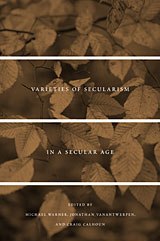 Rich in interdisciplinary breadth, Varieties of Secularism in a Secular Age offers an opportunity to reflect on the reception of Charles Taylor’s magnum opus. Edited by an English professor and two social scientists, it includes contributions from a political philosopher, a sociologist, a theologian, and a literary critic. Given the many reviews of A Secular Age in these disciplines, this mix of contributors is not surprising.
Rich in interdisciplinary breadth, Varieties of Secularism in a Secular Age offers an opportunity to reflect on the reception of Charles Taylor’s magnum opus. Edited by an English professor and two social scientists, it includes contributions from a political philosopher, a sociologist, a theologian, and a literary critic. Given the many reviews of A Secular Age in these disciplines, this mix of contributors is not surprising.
Somewhat more surprising is the inclusion of two historians, members of a discipline that has largely ignored Taylor’s book. Three years after its publication, A Secular Age has yet to be reviewed in the Journal of American History or the American Historical Review.
What explains this lack of interest? Writing in Church History, Martin Marty notes that, while “the ordinary historian has very much to learn from Taylor’s use of history,” it cannot be appropriated “without undertaking a significant act of translating and organizing the material.”
Part of the problem lies in the top-down nature of Taylor’s account, an issue noted by historian Jon Butler in Varieties of Secularism in a Secular Age. According to Butler, “Taylor seldom invokes the experiences of ordinary people,” relying instead on secondary accounts. Criticizing Taylor’s focus on intellectual history, Butler draws on a deep knowledge of colonial American religion, noting that eighteenth-century observers found a combination of belief and unbelief. Together with recent scholarship on medieval and early modern Europe, such accounts challenge Taylor’s tendency to dichotomize the sacred and the secular.
Echoing Butler, historian Jonathan Sheehan questions the use of history in Taylor’s book. Frustrated with its account of an enchanted golden age, Sheehan doubts whether it is possible to know when the purported disenchantment of the world actually took place.
And yet scholars ignore this question at their peril.
In his chapter for Varieties of Secularism in a Secular Age, theologian John Milbank writes of “Bible Belt fundamentalists, who live in a secularized space and time far more extreme than anything found in Europe.” Here in the “Buckle of the Bible Belt,” we are well aware of the evangelicalism Milbank describes. One only has to look as far as Wal-Mart to see the blend of consumer capitalism and Protestant discipline prophesied by Max Weber. At the same time, there is more to this part of America than civil religion and “family values,” though both can be found in abundance in Branson, Missouri.
Take, for example, Good Friday, which recently passed, a day that, Taylor notes, “was important, not only for the theologically orthodox reason, but because the power it carried made it a good day for planting crops, and enabled hot cross buns to save houses from fire.” On such occasions, the residents of pre-modern Europe participated in what Taylor calls “higher times.”
Though Taylor and Milbank relegate such “church magic” to old Europe, similar practices could be found in the Missouri and Arkansas Ozarks as recently as the 1930s. In Ozark Superstitions (published in 1947 by Columbia University Press), folklorist Vance Randolph notes that people “who used to raise hemp for cordage—the same weed that is called marijuana by the moderns—say that this stuff is best planted on Good Friday. Flax must be planted on Good Friday no matter what the weather conditions, according to the old settlers.”
Such folk practices give new meaning to the term “higher times.” They also cast doubt on Taylor’s narrative of disenchantment. Butler says as much in Varieties of Secularism in a Secular Age, noting that Taylor gives inadequate coverage to the mixture of Christian and non-Christian magic in European history.
Focusing on twentieth-century Appalachia, historian Richard J. Callahan documents the persistence of such beliefs in Work and Faith in the Kentucky Coal Fields. Discussing the role of religion in everyday life, he describes how residents used the signs of the Zodiac to govern sowing and reaping, justifying such practices with appeals to both the Bible and the farmer’s almanac.
Too often, chroniclers of Ozark and Appalachian religion have dismissed such practices as the outmoded lifestyles of “our contemporary ancestors,” confined to the “most deliberately unprogressive people in the United States.” Such crude narratives are a version of what Taylor calls “subtraction stories,” emphasizing the disappearance of pre-modern beliefs in the face of progress and science.
Though I doubt many of my neighbors planted hemp on Good Friday, the fact that some twentieth-century Americans continue to experience higher times is relevant to the discussion of A Secular Age. At the very least, such revelations deserve a footnote in this epic story of religion and modernity.











